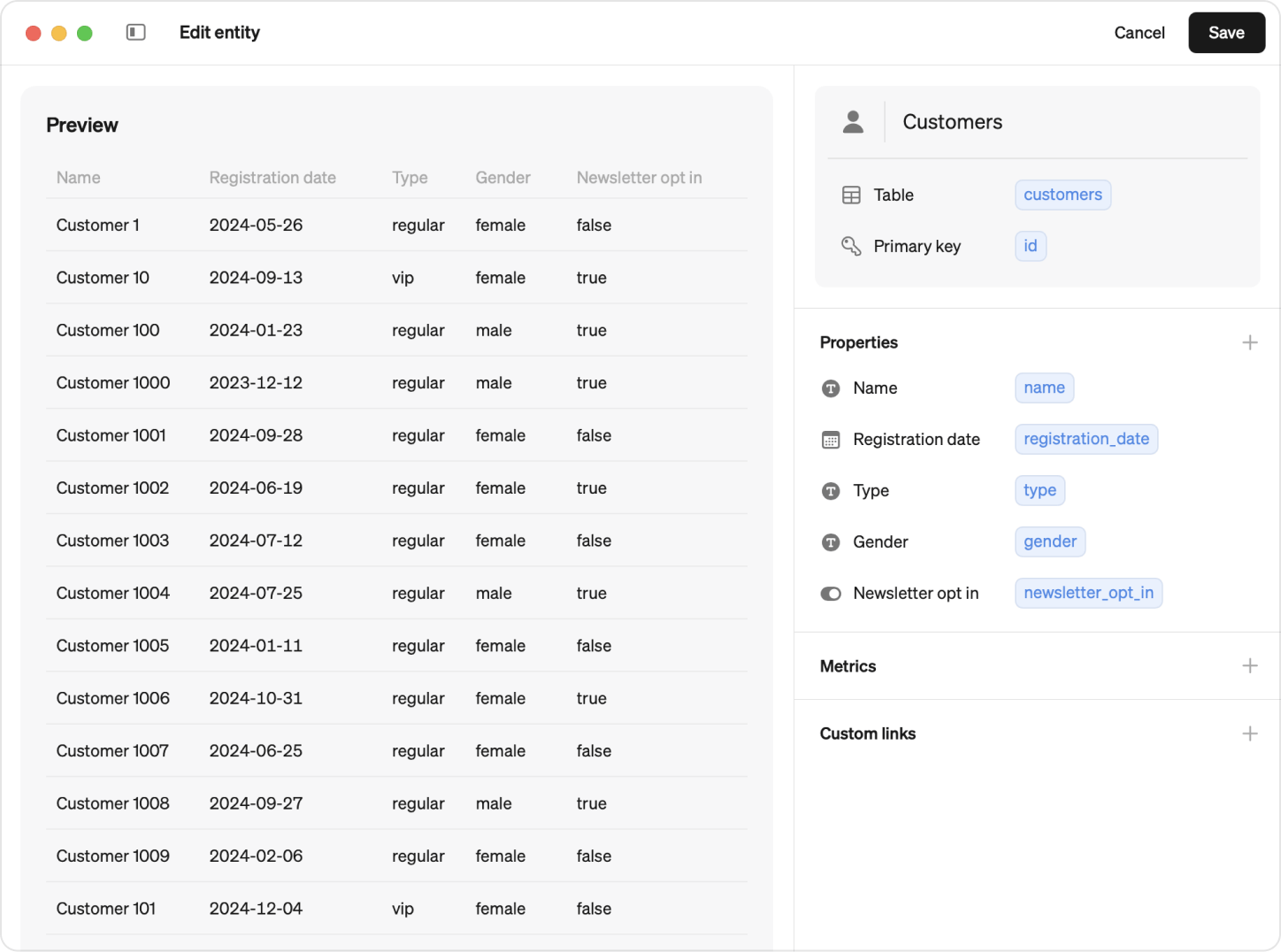By adding entities to your workspace, you enable powerful row-level drill-downs into the records of your data tables.
What Are Entities?
Entities are based on tables from your database. They let you explore row-level data and drill down from metrics to see details like individual customer orders or transactions for a specific day. You can also filter entities and export them to utilize outside of Steep, unlocking powerful operational use cases.
Everyone
Explore and drill down into entities
Admins
Set up and configure entities
Defining entities
Creating and customizing entities is quick and flexible.
How to create a new entity
- Hover over Entities in the sidebar navigation and select +.
- Give your entity a name and choose an icon.
- Select the underlying table and specify the primary key.
- Choose at least one column as a property.
That’s it! Your entity is now ready to use.

Defining properties
Build up your entity by adding properties, which will appear as columns in the entity list and detail pages. You can choose properties from any supported column in the table your entity is based on. Steep can create properties from string, booleans, numbers, date and time columns.

The top property
The top property determines the default sorting order and is used as the title on entity detail pages.
Reorder properties
Drag and drop to rearrange properties. Hover over a property to reveal the handle on the right for dragging.
Editing properties
Click a property to open the property menu:
- Rename - By default the property will be labeled with the column name, you can change it if you like to.
- Icon: Update the default icon with one that better represents the property.
- Column type: Choose to display only the date or date and time (for dates and time properties only).
- Delete: Remove the property from the entity.
Example:
For a User entity, properties could include Name, Email and Signup Date.
Connecting entities to metrics
Link your entities to metrics to enable seamless drill-downs.
Add a metric connection
- Click + next to Metrics to add a metric connection.
- Select a metric based on the same table or a table connected via a dynamic join.
Learn how to set up dynamic joins in the semantic graph →

Drill-downs unlocked
Connecting a metric to an entity allows users to drill down to row-level data from the metric in explore-view, a report or an AI-generated chart.
Example:
Drill down from a Revenue metric to see row-level details of orders contributing to that revenue.

Custom links to external tools
Create dynamic links to external apps, such as Salesforce or HubSpot, using values from your entity table. This generates row-specific links, allowing you to for example, connect a specific user in Steep to the corresponding user in another tool.
Add custom link
- Click + next to Custom links to add a new link
- Add a title and a URL, inserting column values in
{}to generate row-specific links.

Permissions
Everyone in your workspace can view all entities. Only members with permission to metrics can do drill-downs from a metric to entities.
Explore and analyze entities
Entities make it easy to navigate row-level data and gain insights.
Drill-down from metric
- Hover over a chart, click to freeze the popover, and select an entity to view details for a specific point in time.
- You can download the entity list as a CSV by clicking Download in the top right corner.
- Available in metric explore view, reports, and AI-generated charts.


Please note
Metric drill-downs are currently available from line, bar and rank charts
Entity list
Access all entities from the navigation sidebar. From here, you can:
- Filter, sort, or export entity data.
- Open detail views or copy links for sharing.

Filter and sort
- Filter: Apply filters based on text, numbers, dates, or booleans to refine the list.
- Sort: Click column headers to sort the list, toggling between ascending and descending order.

Export to CSV
Export your filtered and sorted entity list. Choose how many rows to include. Note that large exports may take some time.

Copy data
You can copy the data from a filtered and sorted entity list. Click … in the top right corner and select Copy data. Note, the data that will be added to your clipboard is only what is visible on the entity list, which is upto 100 rows. If you want to access more rows, you can export to CSV.

Link to other tools
Entities can be linked to external tools at the row level. These links, accessible from the entity detail page, allow you to navigate directly from an entity in Steep - such as a specific user - to the corresponding record in another system.

Mobile
Drill-downs and entity lists are fully supported on the Steep mobile app.
- You can find the entity lists by navigating to Explore and select Entities at the top
- Use drill-down options directly above chart visualizations for quick access on the go

Data source support
Entities are currently supported on the following databases:
- Athena
- BigQuery
- Databricks
- PostgreSQL
- Redshift
- Snowflake
- MySQL
- Microsoft SQL Server
- Synapse SQL
Please note
dbt Cloud and Cube are not yet supported.
